What could be more intriguing than a portrait of a painter by himself?
Throughout the history of Art, self-portraiture has quickly become an exercise in style well known by artists. Indeed, it responds to two objectives, two intentions for the painter: first, the self-portrait allows him to respond to a trivial need for recognition. Thus, premeditating a posthumous success or a thousand-year-old posterity, self-portraiture allows the artist to offer to a large public the features of a face linked to his technique, his style, or his ambitions. Then, this approach allows him to have perfect control on his image, or at least on his physical appearance: artists, men and women, always show themselves as they wish to be seen by others, but also as they wish to be different from them.
Come aboard with us on a chronological odyssey through the History of Art and discover the greatest jewels of self-representation!
1. Jan van Eyck, Portrait of a Man (Self Portrait), 1433: The Oldest
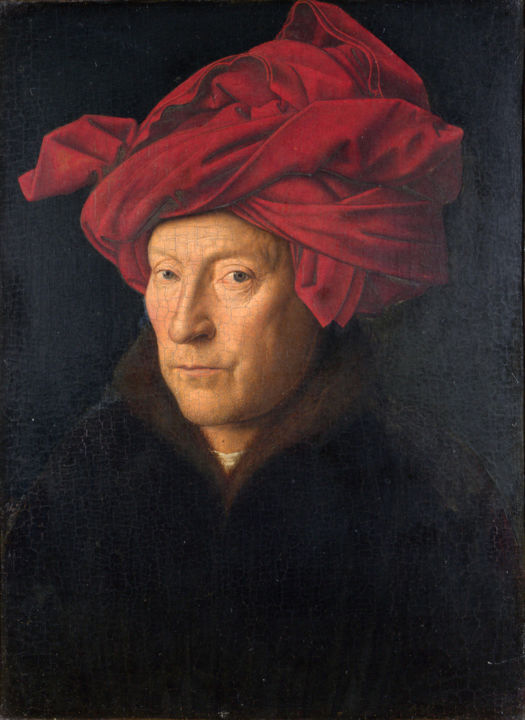 Oil on wood, 26 x 19 cm - London, The National Gallery
Oil on wood, 26 x 19 cm - London, The National Gallery
Before the 15th century, the artist as we define him today (whether he is a painter, sculptor, or weaver) was considered as a craftsman, and as such, his creativity was at the service of high society. He produced for the powerful and never worked on his own: to achieve his personal goals, he was dependent on a hierarchy. This lack of independence, crushing the individual ambitions of artists, explains why there are few or no vestiges of self-portraits before Jan van Eyck's intervention in 1433.
This Flemish primitive was particularly at ease at the end of his life: in 1430, he was named chamberlain to Duke Philip of Burgundy (a sort of luxury concierge) and retained his position as official painter of the City of Bruges. He was therefore very active, and increasingly emancipated himself from his pure function as a craftsman, as a court painter. In 1433, he created the oldest autonomous self-portrait in the History of Art in Europe. It shows the face of a man, in profile and in the prime of life, with a calm and lively gaze staring at the viewer. On his head, a large turban of a dazzling red shows the technical mastery of this great Belgian master.
2. Giorgone, Self-Portrait as David, ca. 1510 :
The most Mysterious
 Oil on canvas, 52 x 43 cm (truncated) - Brunswick, Herzog Anton Ulrich Museum
Oil on canvas, 52 x 43 cm (truncated) - Brunswick, Herzog Anton Ulrich Museum
Shortly after Jan van Eyck's Flemish fervor, it was in Italy that many artists tried their hand at it. Fra Filippo Lippi, a Florentine painter of the First Renaissance, discreetly integrates his face into certain biblical scenes commissioned from him (notably Coronation of the Virgin, circa 1445).
Parmigianino, a young talent from Parma, enjoys depicting his youthful face in a strange trompe-l'oeil (Self-Portrait in a Convex Mirror, 1523). At the same time, Giorgione, practicing in Venice, also decided to use his talent to represent himself. The artwork thus brought into the world was tainted with mysticism: a cold face, barely visible, is hardly able to escape from an opaque darkness.
In fact, the artwork as we know it today is truncated: it has been mutilated, and these alterations have made the true intentions of this self-portrait disappear. Thanks to a 1650 engraving reproducing this painting when it was still intact, we still manage to sketch Giorgione's intentions: originally, he holds Goliath's head in his hand, and thus appears in the role of David, the biblical hero. This is the first allegorical self-portrait in the history of art in Europe, which paved the way for many other talented artists, such as Michelangelo (Self-Portrait on the Skin of Bartholomew) or Caravaggio (David with the Head of Goliath). Unfortunately, Giorgione died a few months after the realization of this portrait, swept away by the plague that raged at the time.
3. Catharina van Hemessen, Self-Portrait, 1548 : The first female self-portrait
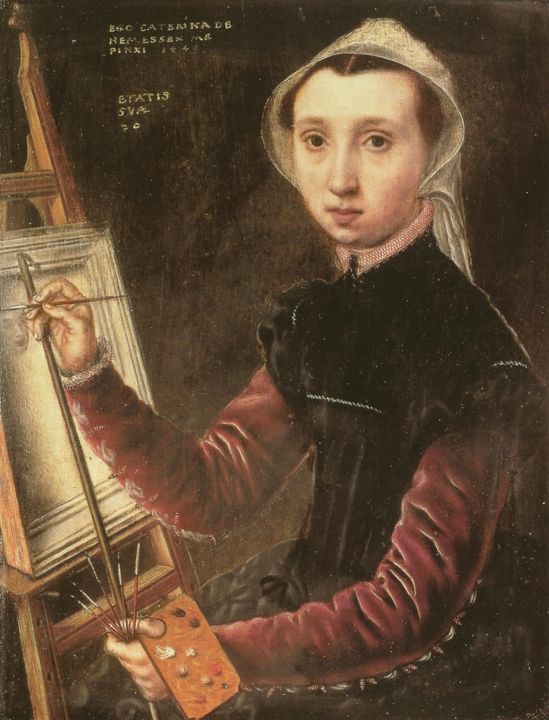 Tempera on wood, 32 x 25 cm - Basel, Kunstmuseum Basel
Tempera on wood, 32 x 25 cm - Basel, Kunstmuseum Basel
Far from the old stereotypes of the man, artist who paints, and the woman, muse who inspires, some women artists have been able to influence artistic production since the early sixteenth century. This is notably the case of Catharina van Hemessen, whose 1548 self-portrait on easel is an early manifestation of this. It is the oldest known example of a self-portrait "on the easel", an exercise in style that will often be repeated through the ages by very famous painters (Rembrandt, Van Gogh, Caillebotte, Magritte ... to name but a few!). We discover a confident woman, who observes us with all the signs of a blossoming creativity: easel, palette, spatula, antique capital letters and brushes arranged in the shape of a cross.
No doubt: this woman is powerful!
4. Antoon van Dyck, Self-portrait with a Sunflower, circa 1635 : The most Sarcastic
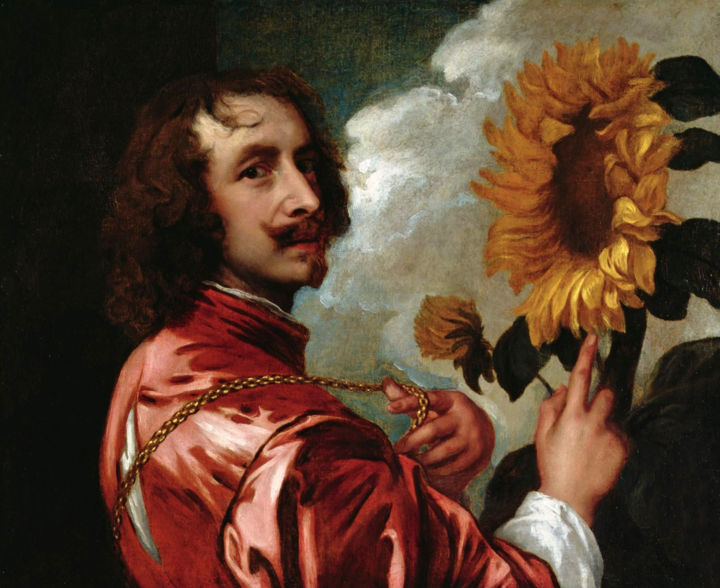 Oil on canvas, 60 x 73 cm - London, Duke of Westminster Collection
Oil on canvas, 60 x 73 cm - London, Duke of Westminster Collection
In the same vein as Jan van Eyck, Antoine van Dyck was also a superstar painter of his time: this Flemish Baroque artist first enjoyed fame in Flanders and then in Italy, before becoming the official painter of the Court in England. After this successful European epic, around 1635, this famous portraitist painted himself as a nobleman in the middle of a conversation with a sunflower. Much more than a simple playful composition, this sunflower symbolizes the King of England Charles I.
It turns its corolla towards the painter, as if it were the sun! This arrangement thus symbolizes royal favor. At the same time, the artist points to the flower with his right hand and, with his left hand, plays with his heavy gold chain, which the king had given him shortly before, as a sign of ennoblement. Within the same artwork, the artist thus succeeds in synthesizing his personal and professional success, between artistic glory and royal prestige, while discussing with the spectator and making fun of the monarch.
5. David Bailly, Self-portrait With Vanitas Symbols, 1651 : The most Intellectual
 Oil on canvas, 89.5 x 122 cm - Leiden, Museum De Lakenhal
Oil on canvas, 89.5 x 122 cm - Leiden, Museum De Lakenhal
The Leiden (Netherlands) artist David Bailly demonstrates in this artwork that it can be easy for a genius painter like him to simultaneously create a magnificent still life and a superb self-portrait. However, good execution of this painting is only the first perception of an artwork full of details and subtleties: we discover a painter sitting at the end of a table, in his studio full of all kinds of objects: sculptures and artistic ornaments, jewelry, accessories, skull, hourglass, ancient scrolls, soap bubbles ready to burst... This artwork overflows with symbols of vanity: an allegorical representation of the passing time, and especially of death.
David Bailly was 67 years old when he created this artwork. He is no longer the proud and vigorous young man who shows us his collection of relics. In fact, the solution to this enigma can be found in the two oval portraits: we discover Bailly's real portrait, as well as the portrait of his wife next to it. The artist has thus represented himself in retrospect, as he saw himself 40 years ago. This self-portrait is thus a look back to the past for its author, although we contemplate an artist showing us his future.
6. Vincent van Gogh, Self-Portrait with Bandaged Ear, 1889 : The Most Unexpected
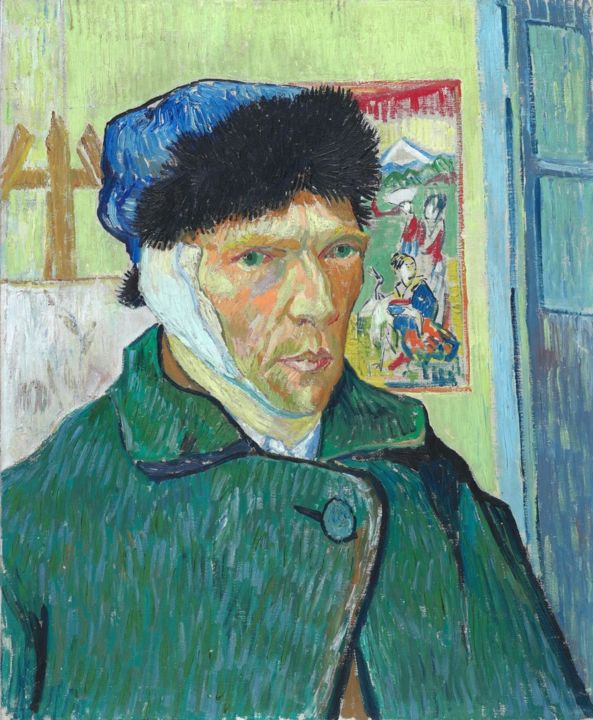 Oil on canvas, 60 x 49 cm - London, The Courtauld Institute of Art
Oil on canvas, 60 x 49 cm - London, The Courtauld Institute of Art
How to approach iconic self-portraits without evoking Van Gogh! In about ten years of work, there are more than 43 self-portraits by the Dutch painter, all more sublime and absurd than the others.
This 1889 self-portrait (one year before his death) was made following the tragic events that took place in Arles. On the 23rd December 1888, a dispute broke out with his friend and fellow artist Paul Gauguin. Taken by anger and in an advanced state of drunkenness, Van Gogh left the studio and wandered around the city, before running aground in a well-known bordello. Armed with a razor blade, he decides to cut off his ear and offer it to Rachel, a prostitute he appreciated, as a relic. He then staggered home, before being found by the police, who took him to the hospital for treatment. Doctors diagnosed him with an alcoholism crisis mixed with schizophrenic self-mutilation: it was soon the end for this decadent melancholy genius, and he was convalescing when he produced this artwork, in which we discover a gaunt face, a livid look and a pale complexion. Behind him, we see a Japanese engraving: it's Geishas in a Landscape by Sato Torakiyo. Great admirer of Asian art, and especially of the Japanese engravings (ukiyo-e) that he discovered in Paris, this new way of arranging colors and composition will follow him throughout his late artwork. A tortured artist with destructive mischief, Van Gogh really felt himself when he painted. No doubt that his self-portraits will mark the history of art forever.
7. Frida Kahlo, Self-Portrait with Cropped Hair, 1940: The most Intimate
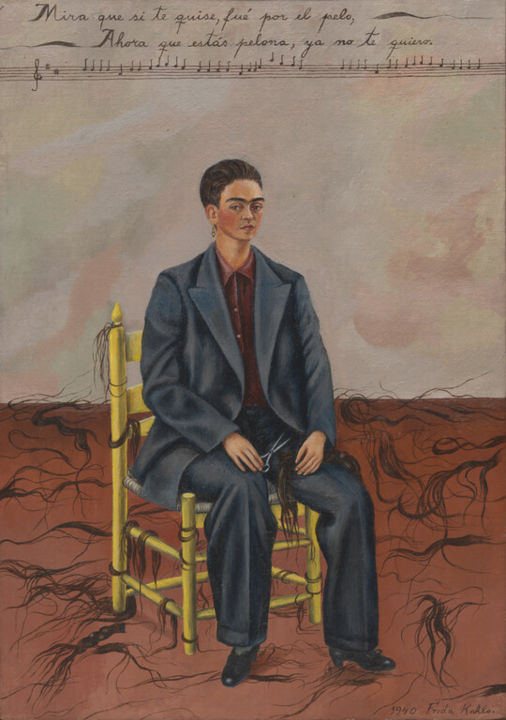 Oil on canvas, 40 x 27.9 cm- New York, Museum of Modern Art
Oil on canvas, 40 x 27.9 cm- New York, Museum of Modern Art
Like Van Gogh, it's difficult to establish a classification of the most emblematic self-portraits without mentioning the most prodigious of Mexican artists: Frida Kahlo. Of the 150 paintings she produced during her lifetime, there are at least 55 self-portraits. The main purpose of these self-representations was to express the various tumults of her existence, since her life was a torment of tragedies and misfortunes: road accident, miscarriages, marital shipwreck, jealousy attacks, alcohol, and disability problems...
This 1940 self-portrait comes a little before the artist was confined to her hospital bed and really suffered from her disability. Nevertheless, it follows the brutal rupture between Frida and Diego Rivera, her soul mate, which caused her to suffer to the point of despair. She's discovered sitting in the centre of an empty room, dressed in a dark and far too large costume, a chisel in her right hand, and locks of hair scattered everywhere. Above all, she casts a quiet, proud, and defiant glance at the observer.
While her majestic and long hair was part of her legend, why perform such an act?
At the top of the composition is the score of a Mexican love song: "Look, if I loved you, it was for your hair; now that you're shorn, I don't love you anymore.". Generally, neglect (divorce) and cut hair (loss of attractiveness) are synonymous with dishonour and humiliation. However, Frida's pose and proud look don't coincide with these allegations. The message she seeks to convey to us is certainly more positive: it' s only with the help of a freely given assurance that one regains one's lost dignity.
To hell with the old far-fetched dogmas, Frida is getting rid of her role tinged with femininity and slavish beauty, to reach a well-deserved reassurance where her personality will be judged only through the prism of her creativity and freedom of being. This self-portrait is a chrysalis through which the artist operates a mutation of his life trajectory.
8. Felix Nussbaum, Self-Portrait with Jewish Identity Card, ca. 1943 : The most Dramatic
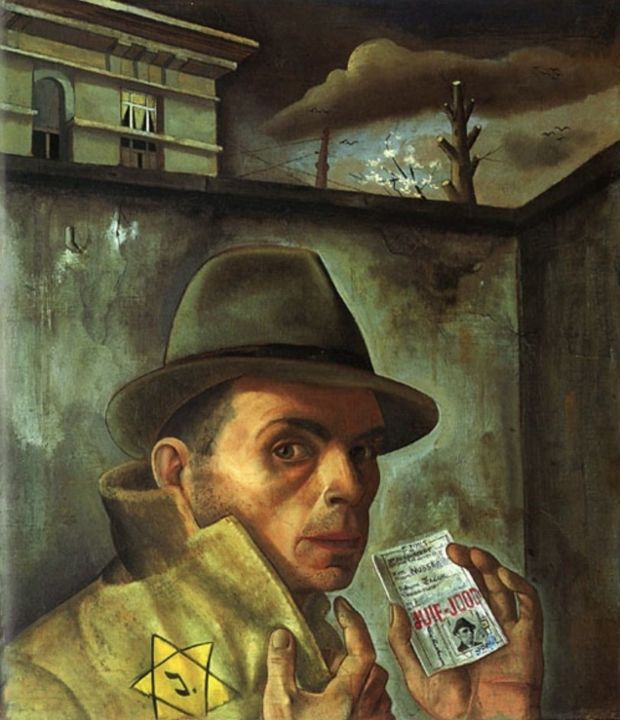 Oil on canvas, 56 x 49 cm - Osnabrück, Felix Nussbaum-Haus
Oil on canvas, 56 x 49 cm - Osnabrück, Felix Nussbaum-Haus
This 1943 self-portrait doesn't respect any of the codes of traditional self-representation. We discover a man, so close to us that we can see his beard hairs, in a position that isn't static: he takes the observer with him, in a flight that seems to lead to nothing but the perspective of an impassable wall. Two elements provide us with context: on the right shoulder of the model, below the collar of the coat that he pulls up as if to point it out to us, we discover a Star of David, symbol of the stigmatization of Jews during the Nazi oppression. In his right hand, he is holding a passport with the inscription "JUIF - JOOD". No doubt, we are facing the atrocity of the World War II, with a man persecuted and locked up arbitrarily, for his beliefs and his belonging.
Felix Nussbaum, author of this tragic self-portrait, was himself a victim of the Nazi regime. Born in Osnabrück (Germany) in 1904 into a Jewish family, he had emigrated in 1933. In 1941, he went into hiding in Brussels and produced his artwork in secret, in cellars or attics with the bare minimum. Despite all this, he kept his energy, the permanent fear of being discovered stimulating his creativity. His artworks will thus be tinged with fear, clandestinity and escape. Through this self-portrait (as well as a large part of his work), he leaves a poignant testimony about the appalling horror of his situation, and offers us a scathing message: Even when everything seems to be hopeless, one must not give up, because in nonrenouncement dignity remains. His hope of survival unfortunately never came true. A few months later, he and his wife were denounced, arrested and deported to Auschwitz where they were killed in 1944.
To conclude, this ranking is obviously not exhaustive. Many artists have made art history with their delicious (and sometimes disconcerting) self-portraits. Some geniuses, such as Albrecht Durer, Rembrandt, Francis Bacon, Diego Rivera, or Egon Schiele, have produced delicate and profound artworks, expressing their inner personality through the appearance of their body envelope. If you have enjoyed this selection, stay tuned as we are already preparing several other articles dealing with emblematic artworks from the Art History. Also, if you like portraits, whether they are simply elegant or intensely deep, we invite you to discover our collection of portraits at less than 1000€, regrouping portraits of talented artists from our platform.
Bastien Alleaume
Content Manager - Artmajeur Online Art Gallery

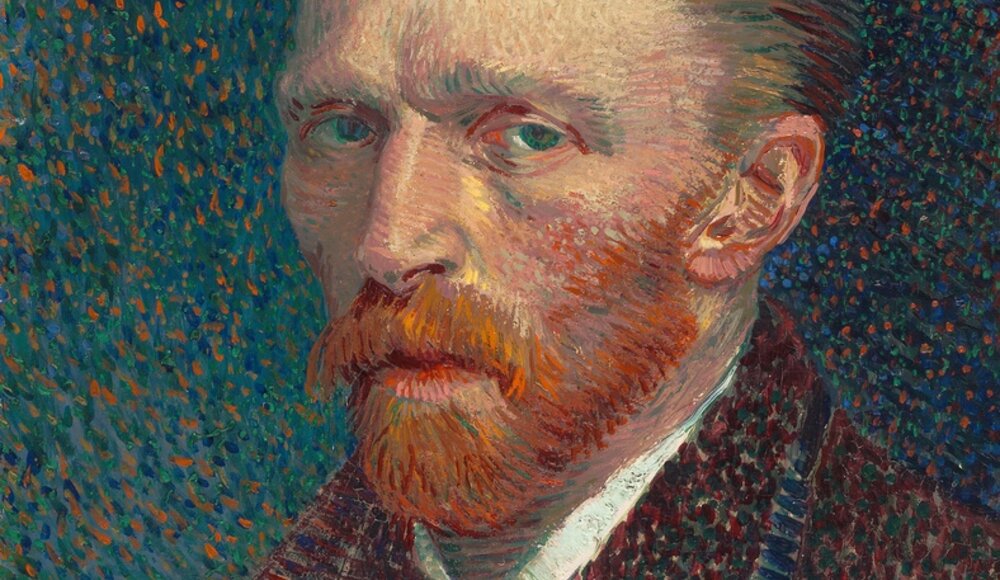

 Bastien Alleaume
Bastien Alleaume